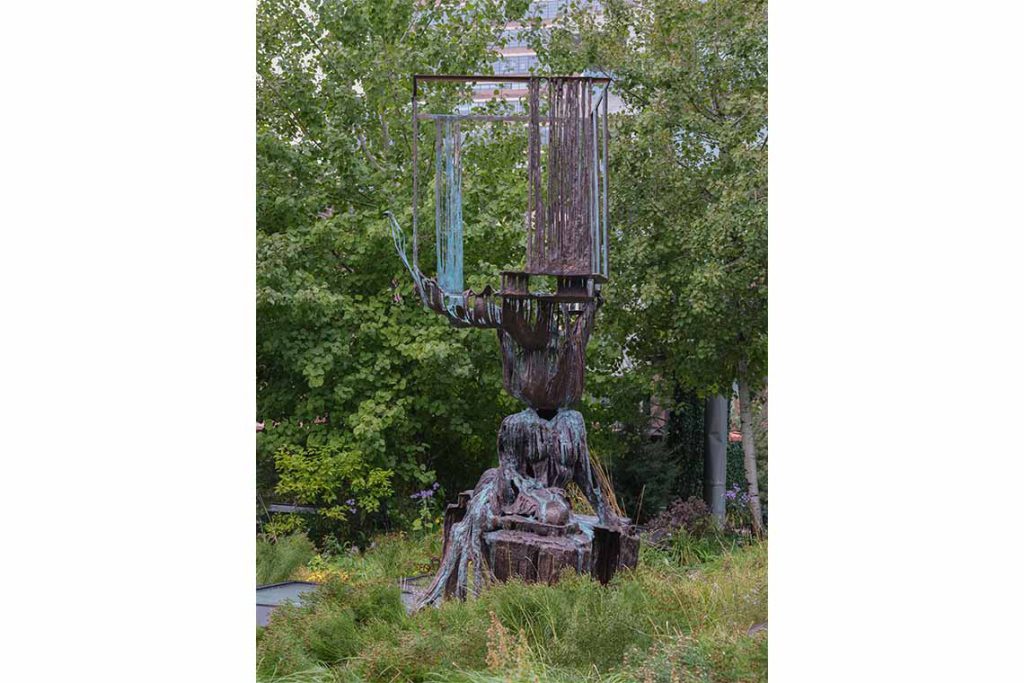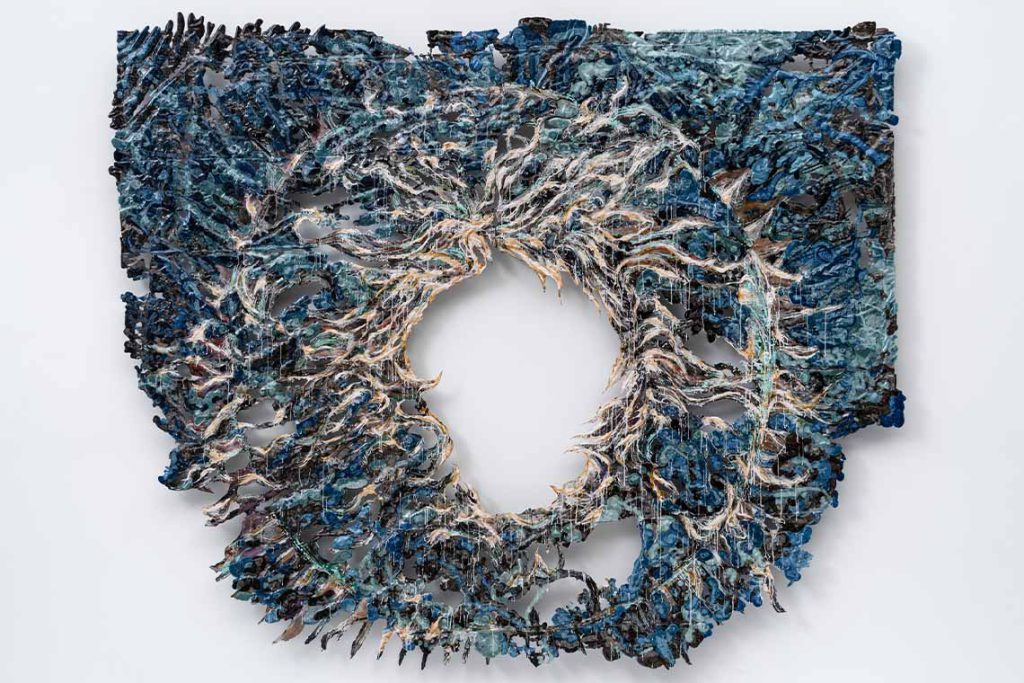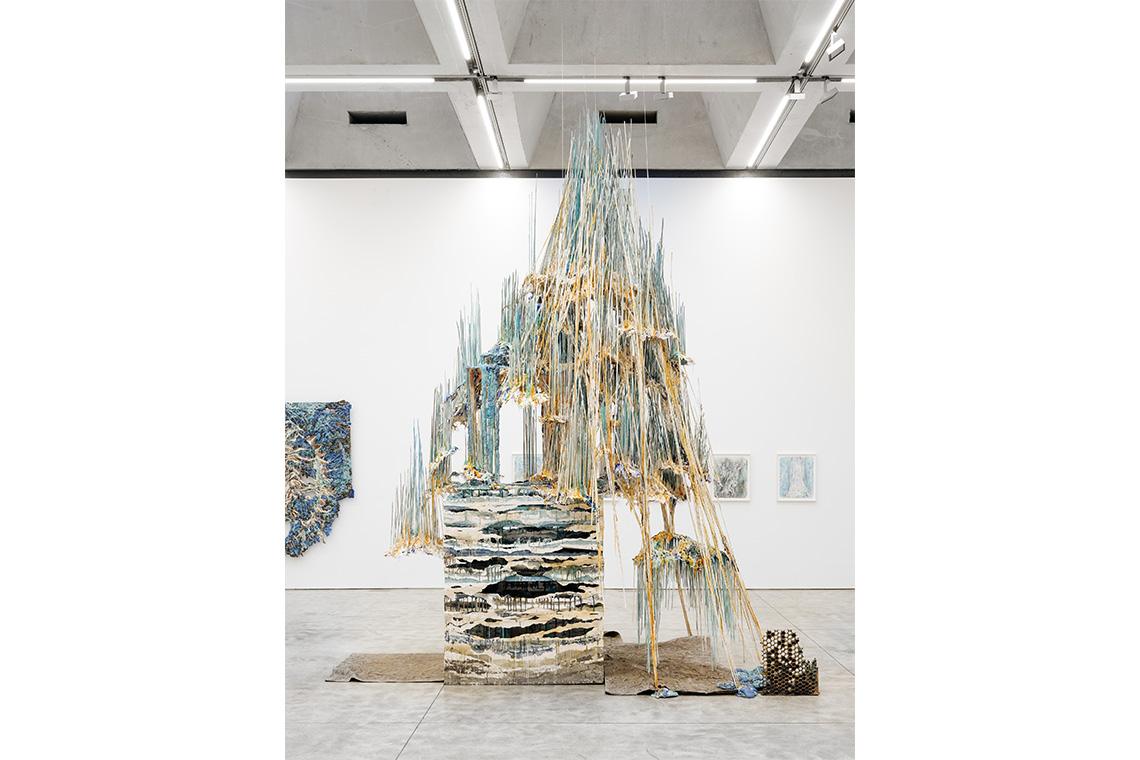Diana Al-Hadid’s current New York show, Women, Bronze, and Dangerous Things at Kasmin Gallery, exemplifies how the artist assembles an intricate world of myth and historicity.
The massive sculpture, Mother Splits the Moon (2023), towers over Diana Al-Hadid’s exhibition, Women, Bronze, and Dangerous Things, at New York’s Kasmin Gallery. With a triangular roof made out of countless spikes and a base for which the same huddle of spikes coalesces with a layered cube, the monumental totem stretches up towards the Chelsea gallery’s ceiling. Its counterpart awaits outside, sitting on Kasmin’s rooftop garden, parallel to the city’s elevated public park, The High Line.
Unlike the clean-cut white cube surrounding its antithesis below, Double Standard (2022) rests amidst nature and the throngs of passersby in constant transformation: trees change from autumn’s yellow to winter’s brittle demise, while walkers pace up and slow down along the narrow pathway. She is a solemn bronze nude whose head comprises tens of upwards drips that form the base of another giant cube reaching towards the Manhattan sky. The female figure is like a Mother Earth, balancing an impossible equilibrium within her likeness, her surroundings and her roots located directly below. The two works’ yin-yang is elusive due to the impossibility of seeing them at once, and their co-dependence a mysterious construction – not unlike the works on paper and in 3D presented throughout the Syrian-born and New York-based artist’s exhibition.

Al-Hadid operates like an architect of myths and histories, all alchemised in variously immediate materials such polymer gypsum, cotton, metal leaf, bronze or linen pulp paint. The tactility in the works’ surfaces – sometimes liquid, or rigid in other cases – extends to her process. Whether flipping the pages of a history book, such as the show’s inspirational title, Women, Fire, and Dangerous Things: What Categories Reveal about the Mind by the American linguist and philosopher George Lakoff (1987), or creating paint out of paper pulp during her residency at the Brooklyn printmaking institution, Dieu Donné, Al-Hadid weaves a potent suite of stories.
While her last few years provide the micro history of Al-Hadid’s show, the wealth of theological myths across the ancient world sets its visual tone. The lapis-washed wall relief Blue Medusa (2023) possesses a hollow middle which frames the outline of the titular mythological figure’s missing head. Tu’bir Albi (2023) is a polymer gypsum, fibreglass, steel, plaster, metal leaf and pigment wall relief, turbulent and serene at once. The mellowness of its title’s connotation in Arabic contrasts its absorbing body; an erratic swirl of drips in a broad colour spectrum dominated by the black challenges an impossible stillness.

The Bride in the Large Glass (2023) is a spectral female silhouette, wearing the weight of bronze like a gentle satin gown. A cage-like head is ensued by the sinuous folds of her gown, which bleeds onto the floor like quicksilver. Between a matriarchal grandiosity and a demure ghostliness, the sculpture radiates its intricate process while absorbing historical references, including Marcel Duchamp’s The Bride Stripped Bare by Her Bachelors, Even (The Large Glass) (1915–23) and the 15th-century Flemish painter Hans Memling’s Allegory of Chastity (1475). As much as the woman’s presence, an absence claims the space – from the figure’s missing face to the intricate holes dotting her bronze cloth. Mountain rocks entrap the woman in Memling’s painting, while in Al-Hadid’s handling, she constructs power through in-betweenness.
In fact, malleability – of bodies or conclusions – constructs Al-Hadid’s liberated approach to the overlap of histories and fables. She leaves open-ended her undertakings, which are always technically demanding and grand in scale. An ornate process of bronze sculpting or paper-making by hand first invites visitors to roam around her works, encountering the variant heights. Next, they are compelled to approach them more closely to discover the intricate surfaces, eventually lifting their heads up to see the full extents attained. Between the material and its absence, Al-Hadid carves room for new mysteries that shift before our eyes and sprout out of the gallery roof.
Women, Bronze, and Dangerous Things runs until 22 December 2023



